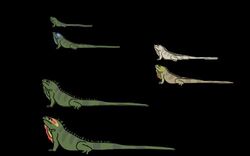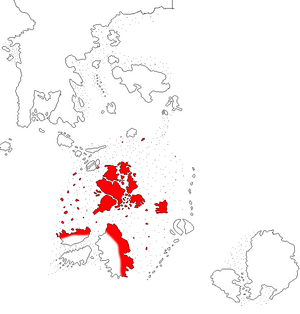Mosh’shalash
| Mosh’shalash | |
|---|---|

| |
| The three Mosh’shalash species, the greater, sand, and blue | |
| Scientific classification | |
| Kingdom: | Animalia
|
| Phylum: | Chordata
|
| Class: | Reptilia
|
| Order: | Squamata
|
| Family: | Mosh’shalashide
|

| |
| Habitat | |
Mosh’shalash (also known as lajanadla in The good old tongue) is a clade of predatory lizards found primarily in the island rainforests and jungles of Vatnahafet. They are medium to large-sized ambush predators and play important ecological roles as apex predators within their respective habitats. There are three recognized species within the clade: the Greater Mosh’shalash, the Sand Mosh’shalash, and the Blue Mosh’shalash. The Greater Mosh’shalash is typically found on the jungle floor, where it uses its green scales to ambush prey. It is the largest of the three species and primarily hunts terrestrial animals. In contrast, the Sand Mosh’shalash is adapted to coastal and shoreline environments. It is well-camouflaged against sandy or rocky substrates, where it ambushes smaller animals that venture onto the shore. the Blue Mosh’shalash is the most derived species in the clade, the Blue Mosh’shalash exhibits a more versatile hunting strategy. It inhabits both the forest floor and the treetops, using the vertical space of the jungle to its advantage. This species is particularly noted for its behavior of dragging prey into the canopy, where it consumes its kills away from the reach of larger predators. All three species share a common predatory behavior, using ambush tactics to capture prey. Their specialized adaptations enable them to thrive in the dense, competitive ecosystems of Vatnahafet’s island rainforests and jungles.
Etymology
The Imerian name Lajanadla directly translates to "Lion Lizard," a term that reflects the creature's ecological role, which is similar to that of great cats in the regions of Scandera and Asterland. The term Mosh'shalash in ancient Zunzhal, translates to "Redthroat," a reference to the vibrant, colorful throats of the lizards. Additionally, these creatures are sometimes referred to as Jarlaadla, a name that has its roots in Scanderan and Asterlander cultural associations. The term Jarl of the jungle is used to describe the lizard, drawing a parallel to the title Jarl of the plains, a title commonly attributed to lions in both Scandera and Asterland.
History
Often considered dangerous and fearsome creatures by most federals, and the greater Mosh’shalash are known for their tendency to become maneaters. This predatory behavior has led to their hunting, particularly among the wealthy and noble classes of the southern regions, where slaying these beasts is sometimes seen as a martial display of prowess. However, this practice is highly perilous, as a wounded Lajanadla that survives an attack is likely to turn fully maneating due to the injuries it has sustained.
In Scandera, the Mosh’shalash are regarded as exotic creatures, and their colorful scales are prized for use in decorative items such as coats, cloaks, and boots. The blue variant of Mosh'shalash is especially sought after and is often kept in gardens in Vattnafalten, not only as a display of wealth but also as a natural means of controlling the population of other lizards in these areas. The blue Mosh’shalash is valued both for its striking appearance and for its utility in maintaining balance within garden ecosystems.
Reproduction
All three species of Mosh’shalash practice r-selected breeding, with females laying large clutches of eggs that are subsequently abandoned. The hatchlings are born fully capable of walking and hunting, often forming small sibling groups as they grow. These groups remain together until the young lizards reach adulthood.
Despite their solitary nature, all species have large nesting colonies that both males and females return to during the breeding season. Males compete for mates by displaying their vibrant, colorful throats and engaging in complex courtship dances. Although combat between males can occur, it is rare, and typically the smaller male will retreat during these mating displays. Once the breeding period ends and the females have laid their eggs, most of the adult lizards leave the colonies to disperse across the islands. The newly hatched young, however, tend to remain near the breeding area until they reach maturity and are ready for their first mating season.
Diet
All three species of Lajanadla are documented hypercarnivores, subsisting entirely on small to mid-sized prey. The blue Mosh’shalash primarily hunts smaller lizards, mammals, and insects, often dragging its prey into trees, which limits its hunting range to animals it can carry.
Known for their exceptionally strong bites, the Mosh’shalash possess thick neck muscles that allow them to deliver crushing blows, consuming most of the animals they catch, including bones. As generalist predators, they have no specific dietary preferences, and the larger Mosh’shalash species is even known to occasionally prey on humans when the opportunity arises.
Behaviour
Being cold-blooded, Mosh’shalash do not require as high a caloric intake as warm-blooded mammals, allowing them to subsist on a much smaller diet. This reduces their need for territorial behavior, and as a result, they are not particularly aggressive about defending space. Instead, they are known to roam the islands at a leisurely pace or bask in the sun when not lying in ambush, typically around dawn and evening.
This relaxed hunting style enables Mosh’shalash to support not only a larger population but also a higher population density compared to a similarly-sized mammalian species. As a result, they are common and widespread predators, contributing significantly to the dangers of the jungles they inhabit.
Life expectancy
The tan and blue Mosh’shalash typically live to around 10 years of age, while the Greater Mosh’shalash can reach up to 20 years. One particularly notable individual, housed at the Great Library, has surpassed even this lifespan, reaching the extraordinary age of 30. This Mosh’shalash, affectionately known as "Goran alde basten" (translated as "Goran the Old Beast"), is a popular tourist attraction and a beloved figure within the library's zoological garden. Goran's age and status have made him a symbol of wisdom and good fortune, especially among students.
A widespread belief has emerged that feeding Goran meat before exams brings good luck, resulting in a peculiar and ongoing "arms race" between students and his keepers. Students vie to offer him the best meat, while the library staff attempts to prevent these offerings to maintain Goran's health. As a result, Goran has gained a few extra kilos during exam seasons, much to the amusement of visitors.
In response to this, the Great Library has established a shrine dedicated to Goran's spirit, allowing people to offer sacrifices to a fetish representing the old beast. While the shrine has grown increasingly popular, it has not completely stopped students from continuing their feeding practices, ensuring that Goran remains a central figure in both the library's traditions and student culture.